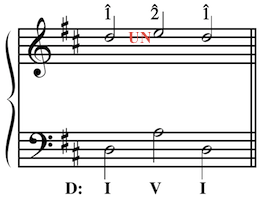
HARMONIC EXPANSIONS
CHAPTER 1: EXPANDING THE TONIC TRIAD; THE FUNDAMENTAL HARMONIC PROGRESSION
1.4 Expanding the tonic triad with upper neighbors
 |
 |
 |
|
Illustration 1. Soprano scale degrees 1, 2, 1 at the end of a hymn. |
Illustration 2. Scale degree 2 as upper neighbor |
Illustration 1 is the last phrase of a hymn in Hymnal for Colleges and Schools, which ends with scale degrees 1, 2, 1 in the soprano accompanied by I V I in the lower voices. During these last three chords inner voices move up and down by third. When the fundamental harmonic progression has scale degrees 1, 2, 1 in the soprano, the embellishing tone, 2, is called an upper neighbor, labeled "UN" in Illustration 2.
Listen to upper neighbors (in different harmonic contexts) in “Silent Night” by Franz Gruber and performed by Sally Fletcher...
|
|
Your turn. Write I V I progressions with upper neighbors, as in Examples 1 and 2 above. 1. DOWNLOAD pdf file 01.4 to print and write on. 2. ENTER your part writing on the Harmonic Expansions 1.4 page in Noteflight. |
 |
 |
 |
 |
 |
Comments? Click here. |



